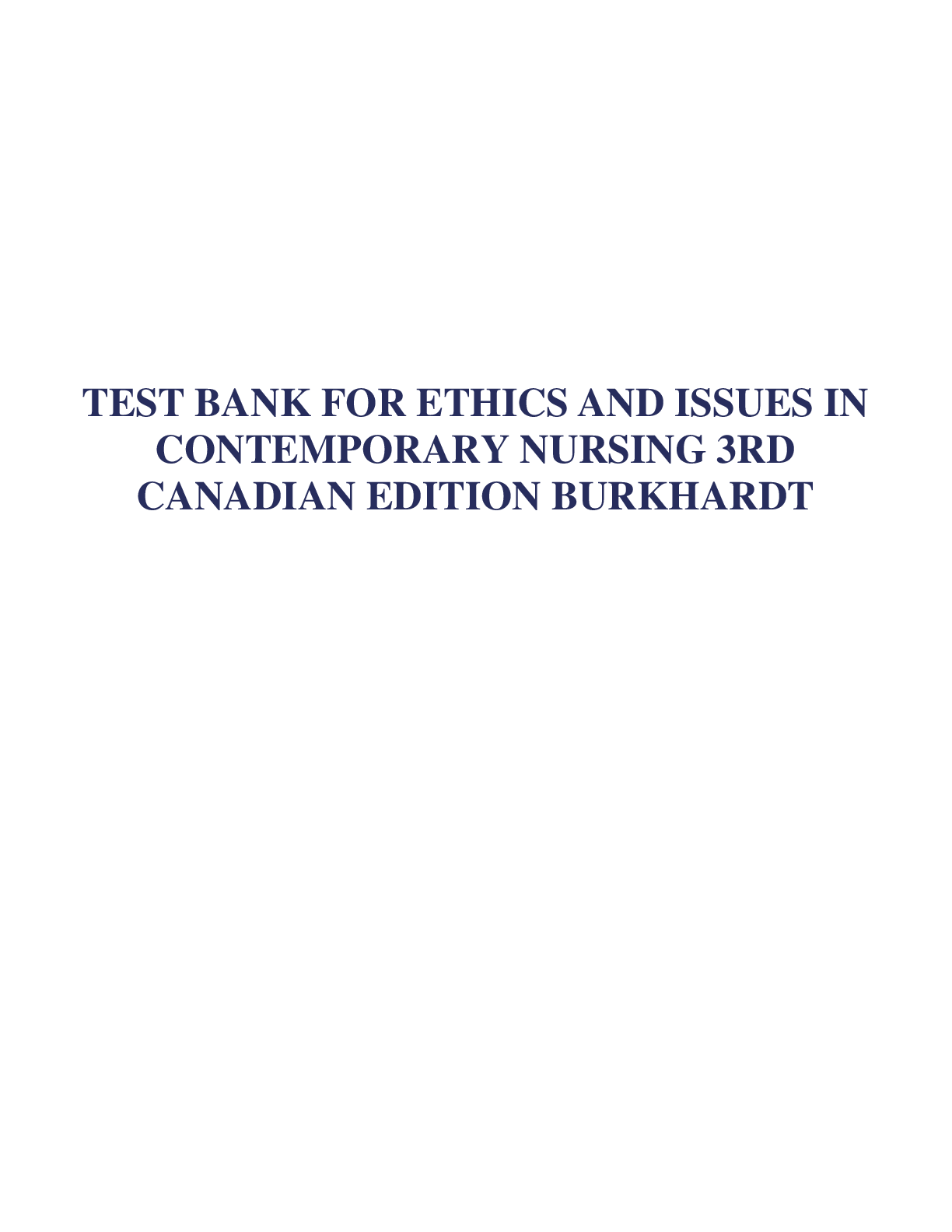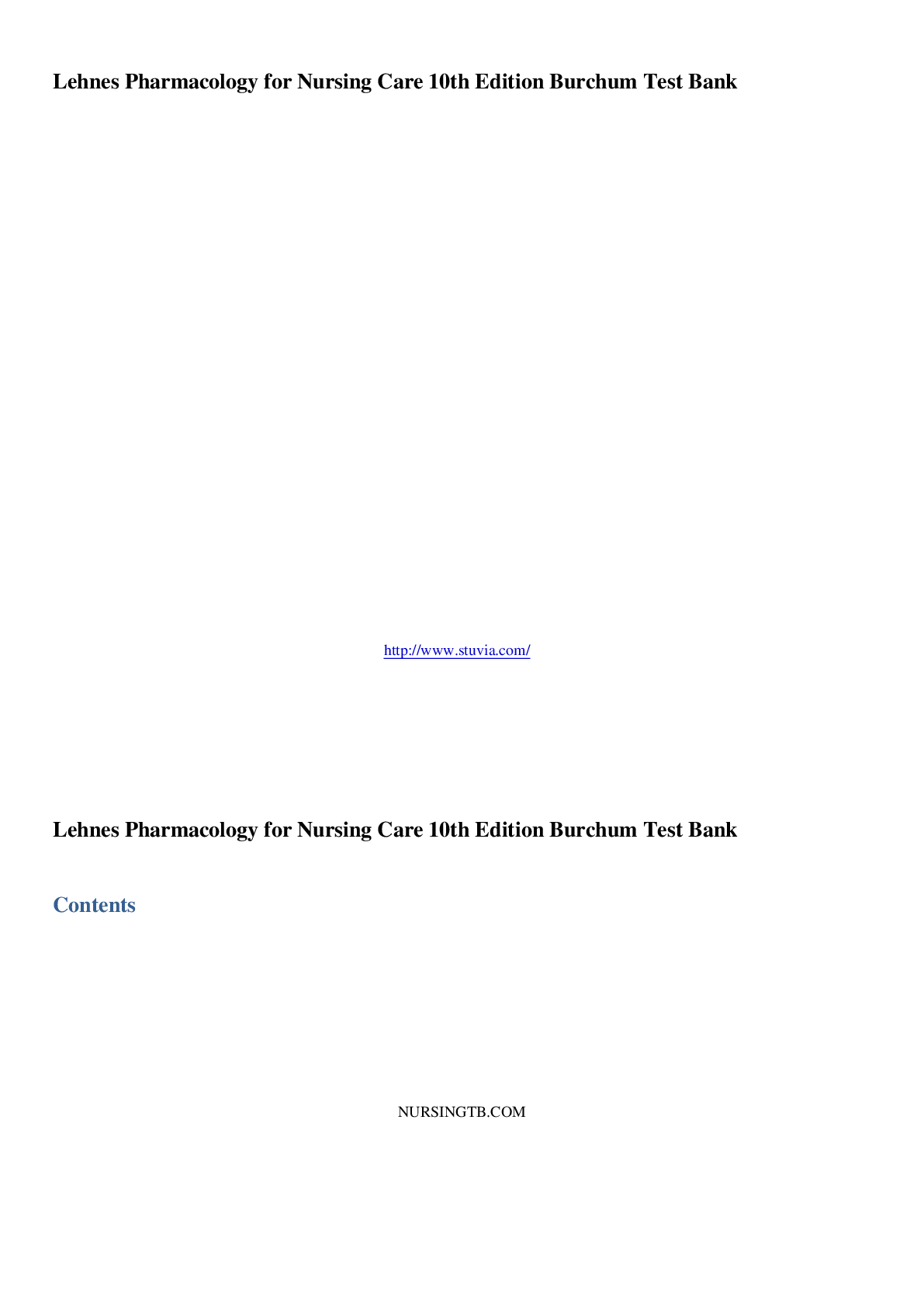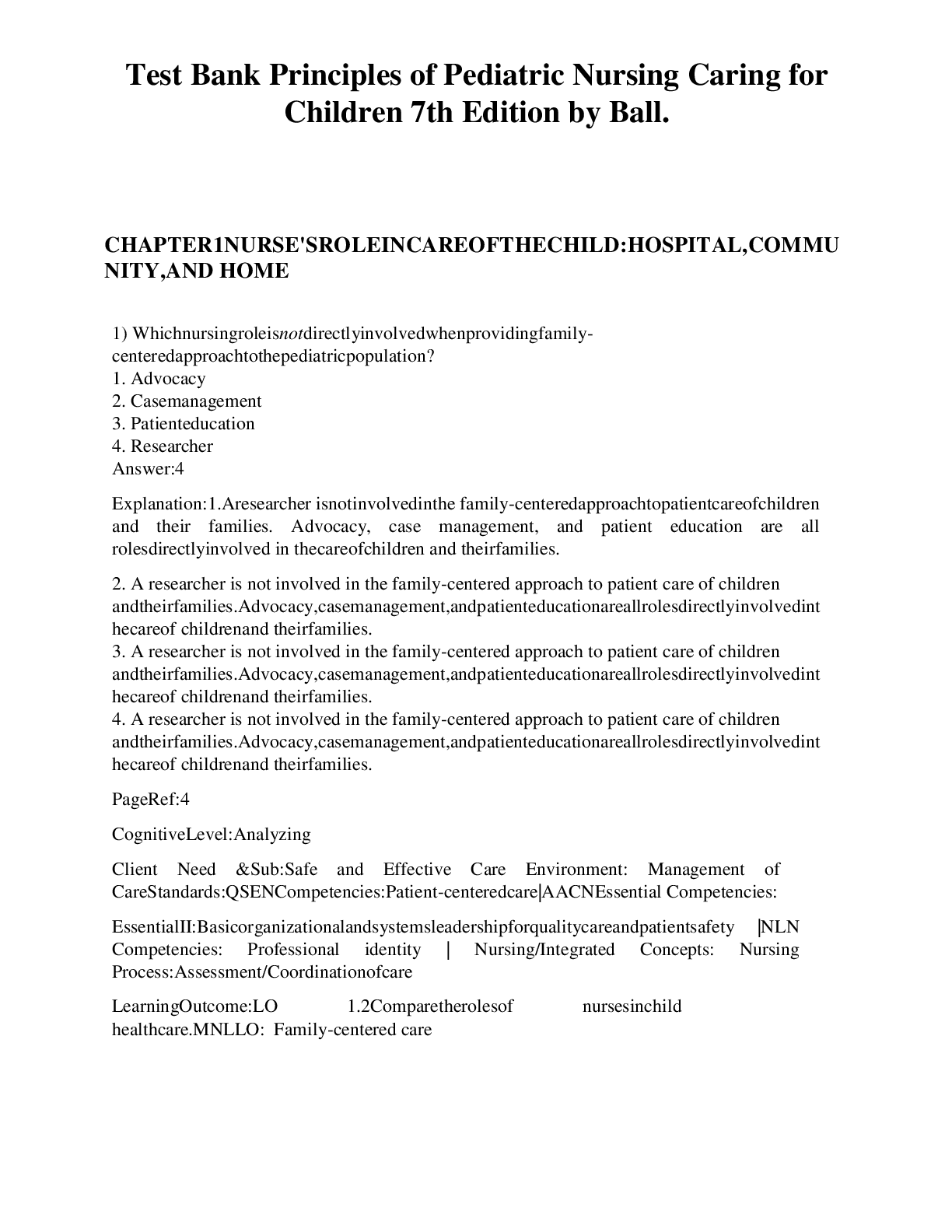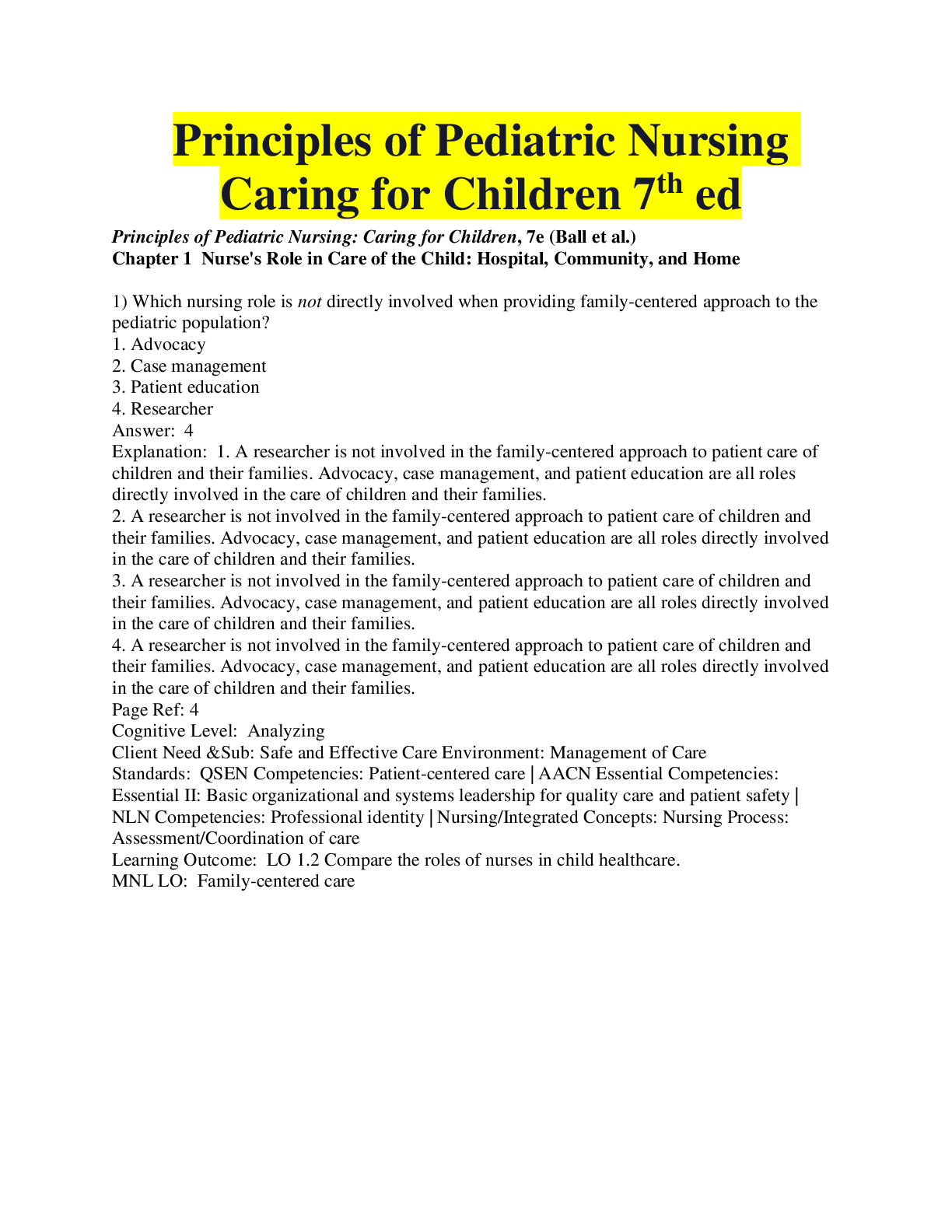*NURSING > TEST BANK > PRINCIPLES OF PEDIATRIC NURSING CARING FOR CHILDREN 7TH EDITION LATEST UPDATED TEST BANK (All)
PRINCIPLES OF PEDIATRIC NURSING CARING FOR CHILDREN 7TH EDITION LATEST UPDATED TEST BANK
Document Content and Description Below
Chapter 1 Nurse's Role in Care of the Child: Hospital, Community, and Home 1) Which nursing role is not directly involved when providing family-centered approach to the pediatric population? 1. Ad... vocacy 2. Case management 3. Patient education 4. Researcher Answer: 4 Explanation: 1. A researcher is not involved in the family-centered approach to patient care of children and their families. Advocacy, case management, and patient education are all roles directly involved in the care of children and their families. 2. A researcher is not involved in the family-centered approach to patient care of children and their families. Advocacy, case management, and patient education are all roles directly involved in the care of children and their families. 3. A researcher is not involved in the family-centered approach to patient care of children and their families. Advocacy, case management, and patient education are all roles directly involved in the care of children and their families. 4. A researcher is not involved in the family-centered approach to patient care of children and their families. Advocacy, case management, and patient education are all roles directly involved in the care of children and their families. Page Ref: 4 Cognitive Level: Analyzing Client Need &Sub: Safe and Effective Care Environment: Management of Care Standards: QSEN Competencies: Patient-centered care | AACN Essential Competencies: Essential II: Basic organizational and systems leadership for quality care and patient safety | NLN Competencies: Professional identity | Nursing/Integrated Concepts: Nursing Process: Assessment/Coordination of care Learning Outcome: LO 1.2 Compare the roles of nurses in child healthcare. MNL LO: Family-centered care 2) A nurse is working with pediatric clients in a research facility. The nurse recognizes that federal guidelines are in place that delineate which pediatrics clients must give assent for participation in research trials. Based upon the client's age, the nurse would seek assent from which children? Select all that apply. 1. The precocious 4-year-old commencing as a cystic fibrosis research-study participant. 2. The 7-year-old leukemia client electing to receive a newly developed medication, now being researched. 3. The 10-year-old commencing in an investigative study for clients with precocious puberty. 4. The 13-year-old client commencing participation in a research program for Attention Deficit Hyperactivity Disorder (ADHD) treatments. Answer: 2, 3, 4 Explanation: 1. Federal guidelines mandate that research participants 7 years old and older must receive developmentally appropriate information about healthcare procedures and treatments and give assent. 2. Federal guidelines mandate that research participants 7 years old and older must receive developmentally appropriate information about healthcare procedures and treatments and give assent. 3. Federal guidelines mandate that research participants 7 years old and older must receive developmentally appropriate information about healthcare procedures and treatments and give assent. 4. Federal guidelines mandate that research participants 7 years old and older must receive developmentally appropriate information about healthcare procedures and treatments and give assent. Page Ref: 11, 12 Cognitive Level: Applying Client Need &Sub: Psychosocial Integrity Standards: QSEN Competencies: Patient-centered care | AACN Essential Competencies: Essential V: Healthcare policy, finance, and regulatory environments | NLN Competencies: Nursing judgement | Nursing/Integrated Concepts: Nursing Process: Planning/Coordination of care Learning Outcome: LO 1.6 Examine three unique pediatric legal and ethical issues in pediatric nursing practice. MNL LO: Developmentally appropriate care 3) The nurse in a pediatric acute care unit is assigned the following tasks. Which task is not appropriate for the nurse to complete? 1. Diagnose an 8-year-old with acute otitis media and prescribe an antibiotic. 2. Listen to the concerns of an adolescent about being out of school for a lengthy surgical recovery. 3. Provide information to a mother of a newly diagnosed 4-year-old diabetic about local support- group options. 4. Diagnose a 6-year-old with Diversional Activity Deficit related to placement in isolation. Answer: 1 Explanation: 1. The role of the pediatric nurse includes providing nursing assessment, directing nursing care interventions, and educating client and family at developmentally appropriate levels; client advocacy, case management, minimization of distress, and enhancement of coping. Advanced practice nurse practitioners perform assessment, diagnosis, and management of health conditions. 2. The role of the pediatric nurse includes providing nursing assessment, directing nursing care interventions, and educating client and family at developmentally appropriate levels; client advocacy, case management, minimization of distress, and enhancement of coping. Advanced practice nurse practitioners perform assessment, diagnosis, and management of health conditions. 3. The role of the pediatric nurse includes providing nursing assessment, directing nursing care interventions, and educating client and family at developmentally appropriate levels; client advocacy, case management, minimization of distress, and enhancement of coping. Advanced practice nurse practitioners perform assessment, diagnosis, and management of health conditions. 4. The role of the pediatric nurse includes providing nursing assessment, directing nursing care interventions, and educating client and family at developmentally appropriate levels; client advocacy, case management, minimization of distress, and enhancement of coping. Advanced practice nurse practitioners perform assessment, diagnosis, and management of health conditions. Page Ref: 2-4 Cognitive Level: Applying Client Need &Sub: Safe and Effective Care Environment: Management of Care Standards: QSEN Competencies: Patient-centered care | AACN Essential Competencies: Essential II: Basic organizational and systems leadership for quality care and patient safety | NLN Competencies: Professional identity | Nursing/Integrated Concepts: Nursing Process: Implementation/Coordination of care Learning Outcome: LO 1.2 Compare the roles of nurses in child healthcare. MNL LO: Pediatric nursing care 4) A 7-year-old child is admitted for acute appendicitis. The parents are questioning the nurse about expectations during the child's recovery. Which information tool would be most useful in answering a parent's questions about the timing of key events? 1. Healthy People 2020 2. Clinical pathways 3. Child mortality statistics 4. National clinical practice guidelines Answer: 2 Explanation: 1. Clinical pathways are interdisciplinary documents provided by a hospital to suggest ideal sequencing and timing of events and interventions for specific diseases to improve efficiency of care and enhance recovery. This pathway serves as a model outlining the typical hospital stay for individuals with specified conditions. Healthy People 2020 contains objectives set by the U.S. government to improve the health and reduce the incidence of death in the twenty-first century. Child mortality statistics can be compared with those from other decades for the evaluation of achievement toward health-care goals. National clinical practice guidelines promote uniformity in care for specific disease conditions by suggesting expected outcomes from specific interventions. 2. Clinical pathways are interdisciplinary documents provided by a hospital to suggest ideal sequencing and timing of events and interventions for specific diseases to improve efficiency of care and enhance recovery. This pathway serves as a model outlining the typical hospital stay for individuals with specified conditions. Healthy People 2020 contains objectives set by the U.S. government to improve the health and reduce the incidence of death in the twenty-first century. Child mortality statistics can be compared with those from other decades for the evaluation of achievement toward health-care goals. National clinical practice guidelines promote uniformity in care for specific disease conditions by suggesting expected outcomes from specific interventions. 3. Clinical pathways are interdisciplinary documents provided by a hospital to suggest ideal sequencing and timing of events and interventions for specific diseases to improve efficiency of care and enhance recovery. This pathway serves as a model outlining the typical hospital stay for individuals with specified conditions. Healthy People 2020 contains objectives set by the U.S. government to improve the health and reduce the incidence of death in the twenty-first century. Child mortality statistics can be compared with those from other decades for the evaluation of achievement toward health-care goals. National clinical practice guidelines promote uniformity in care for specific disease conditions by suggesting expected outcomes from specific interventions. 4. Clinical pathways are interdisciplinary documents provided by a hospital to suggest ideal sequencing and timing of events and interventions for specific diseases to improve efficiency of care and enhance recovery. This pathway serves as a model outlining the typical hospital stay for individuals with specified conditions. Healthy People 2020 contains objectives set by the U.S. government to improve the health and reduce the incidence of death in the twenty-first century. Child mortality statistics can be compared with those from other decades for the evaluation of achievement toward health-care goals. National clinical practice guidelines promote uniformity in care for specific disease conditions by suggesting expected outcomes from specific interventions. Page Ref: 1, 2 Cognitive Level: Applying Client Need &Sub: Psychosocial Integrity Standards: QSEN Competencies: Patient-centered care | AACN Essential Competencies: Essential II: Basic organizational and systems leadership for quality care and patient safety | NLN Competencies: Nursing judgement | Nursing/Integrated Concepts: Nursing Process: Planning/Health teaching and health promotion Learning Outcome: LO 1.1 Describe the continuum of pediatric healthcare. MNL LO: Family-centered care 5) The nurse recognizes that the pediatric client is from a cultural background different from that of the hospital staff. Which goal is most appropriate for this client when planning nursing care? 1. Overlook or minimize the differences that exist. 2. Facilitate the family's ability to comply with the care needed. 3. Avoid inadvertently offending the family by imposing the nurse's perspective. 4. Encourage complementary beneficial cultural practices as primary therapies. Answer: 2 [Show More]
Last updated: 2 years ago
Preview 1 out of 359 pages

Buy this document to get the full access instantly
Instant Download Access after purchase
Buy NowInstant download
We Accept:

Reviews( 0 )
$17.00
Can't find what you want? Try our AI powered Search
Document information
Connected school, study & course
About the document
Uploaded On
Oct 14, 2022
Number of pages
359
Written in
Additional information
This document has been written for:
Uploaded
Oct 14, 2022
Downloads
0
Views
73



















